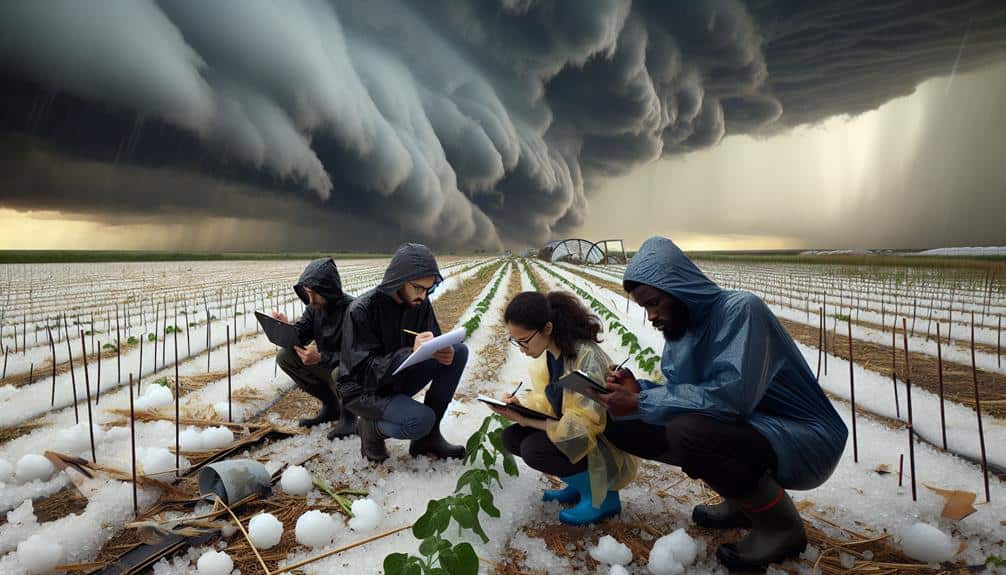By studying hailstorms up close, we can greatly enhance our ability to predict severe weather events with greater precision and timeliness. Integrating remote sensing technologies like advanced radars and satellites allows us to capture detailed storm dynamics, which improves climate models and long-term weather simulations. This high-resolution data helps refine algorithms and identify high-risk zones, leading to improved early-warning systems and agile emergency responses. Additionally, our research supports agricultural planning by predicting vulnerable periods for crops, and it enables innovations in building materials to mitigate hailstorm impacts. Explore further to understand the broader implications of our findings.
Key Points
- Utilize advanced radars and satellites to capture high-resolution storm dynamics.
- Conduct thorough risk assessments to improve early-warning systems and emergency response strategies.
- Enhance accuracy and timeliness of weather predictions by integrating remote sensing technologies.
- Leverage hailstorm data to refine climate models and improve long-term weather simulations.
Enhancing Weather Predictions
By studying hailstorms up close, we can enhance the accuracy and timeliness of weather predictions, providing important data for meteorological models. Our approach integrates remote sensing technologies and meticulous data analysis to capture high-resolution storm dynamics. Utilizing advanced radars and satellites, we gather detailed information on hail size, distribution, and storm movement. This data is pivotal for refining predictive algorithms and improving the precision of weather forecasts.
In our meteorological research, field campaigns play a vital role. These campaigns involve deploying teams equipped with specialized instruments to areas frequently affected by hailstorms. By collecting on-the-ground observations, we can validate and complement remote sensing data. The synergy between field data and remote sensing allows us to construct more detailed meteorological models.
Remote sensing provides a macroscopic view of storm systems, while field data offers granular insights. Combining these perspectives through rigorous data analysis enhances our understanding of hailstorm formation and progression. This dual approach not only boosts forecast accuracy but also shortens lead times for severe weather warnings, giving individuals and communities more time to take protective measures.
Ultimately, our work in studying hailstorms up close empowers us all to navigate the uncertainties of weather with greater confidence and freedom.
Advancing Climate Models
Leveraging data from our hailstorm studies, we can greatly enhance the granularity and reliability of climate models. By integrating high-resolution data collected from field experiments, we're able to feed unprecedentedly detailed information into our data analysis pipelines. This granular data allows us to refine the algorithms that predict climate patterns, enabling more accurate simulations of atmospheric conditions.
Our field experiments involve deploying advanced sensors and radar systems directly into hailstorm environments. These instruments capture real-time variables such as wind speed, temperature gradients, and hailstone formation processes. The data we collect undergoes rigorous data analysis to identify patterns and anomalies that were previously undetectable with conventional methods.
By improving our understanding of hailstorm microphysics, we can incorporate these insights into climate models that simulate long-term weather patterns. This results in models that not only predict hailstorm occurrences with greater precision but also provide a clearer picture of how such events impact broader climatic trends.
Moreover, as we accumulate more data, machine learning algorithms can further enhance model accuracy, offering a robust tool for climate scientists and policymakers. Ultimately, our approach empowers us to make more informed decisions, fostering a future where freedom is bolstered by reliable, actionable climate insights.
Improving Safety Protocols
How can we enhance safety protocols to better protect communities in hailstorm-prone regions?
First, we need thorough risk assessments that evaluate both historical data and real-time weather patterns. By identifying high-risk zones and periods, we can prioritize resource allocation and emergency response measures more effectively. Utilizing advanced radar and satellite technologies, we can improve early-warning systems, giving residents more time to seek shelter.
Next, our emergency response strategies must be agile and well-coordinated. This includes regular training for first responders and community drills to make sure everyone knows their role during a hailstorm. Clear communication channels are essential; we should leverage social media, text alerts, and community loudspeakers to disseminate urgent information swiftly.
Moreover, building codes and infrastructure need to be updated to withstand hail damage. This involves using impact-resistant materials for roofs, windows, and siding. Communities should also have designated safe zones, such as reinforced public buildings where people can take refuge during severe storms.
Supporting Agricultural Planning
While enhancing safety protocols is paramount for community protection, we must also focus on supporting agricultural planning to mitigate hailstorm damage to crops and livestock. By studying hailstorms up close, we can develop advanced crop protection strategies that directly contribute to yield optimization.
Utilizing high-resolution data on hailstorm patterns, we can predict vulnerable periods and advise farmers on the best times for planting and harvesting, maximizing their crop yield.
Moreover, integrating this data into sophisticated risk models allows us to refine insurance policies, providing more accurate risk mitigation for farmers. When insurance companies have access to precise information about hailstorm frequency and intensity, they can offer tailored policies that better cover potential losses. This not only protects farmers financially but also encourages them to adopt innovative agricultural practices without fear of devastating losses.
Additionally, our research can inform the development of more resilient crop varieties, engineered to withstand hail damage. By combining meteorological data with agronomic research, we can foster a proactive approach to agricultural planning.
Ultimately, by prioritizing crop protection and yield optimization alongside well-structured insurance policies, we empower farmers to thrive despite the challenges posed by hailstorms.
Innovating Building Materials

By studying hailstorm impacts, we can develop innovative building materials that greatly enhance structural resilience against severe weather conditions. Our research focuses on smart materials and advanced engineering solutions to mitigate hail damage.
Smart materials, such as shape-memory alloys and self-healing polymers, adapt to environmental changes and recover from damage autonomously. These materials offer a dynamic response to the high-velocity impact of hailstones, reducing the need for frequent repairs.
We also explore composite materials that combine the strength of traditional substances with the flexibility of modern polymers. These composites can dissipate impact energy more effectively, minimizing structural damage.
Our engineering solutions include testing various material configurations under simulated hail conditions to identify best performance characteristics.
Frequently Asked Questions
How Can Researchers Safely Observe Hailstorms up Close?
We can safely observe hailstorms up close by utilizing drone observation and implementing stringent safety precautions. Drones provide real-time data while keeping us at a safe distance, minimizing the risks associated with direct exposure to severe weather conditions.
What Technology Is Used to Study Hailstorms in Real-Time?
Of course, we love risking our lives! But instead, we use Doppler radars and weather balloons to study hailstorms in real-time. These tools provide essential data on storm structure, dynamics, and hail formation while keeping us safe.
Are There Any Notable Recent Discoveries From Hailstorm Research?
We've recently discovered that hailstone composition is notably affected by climate change impact. Our studies show that increasing temperatures alter internal structures, leading to more frequent, larger hailstones. This finding has critical implications for future weather predictions and safety measures.
How Do Hailstorms Form and Develop?
Hailstorms form like a rolling snowball, starting with strong updrafts lifting water droplets. These droplets freeze and develop through repeated cycles, growing larger until they're too heavy and fall as hail. It's a fascinating process.
What Are the Economic Impacts of Hailstorms on Affected Communities?
We see significant economic impacts from hailstorms, including a surge in insurance claims and substantial crop damage. These events disrupt local economies, strain financial resources, and challenge community resilience, affecting long-term growth and stability.


